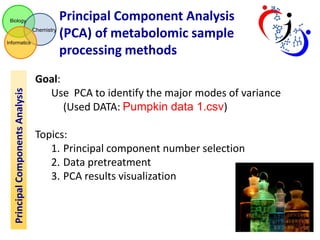
3 principal components analysis
- 1. Biology Chemistry Principal Components Analysis Informatics Principal Component Analysis (PCA) of metabolomic sample processing methods Goal: Use PCA to identify the major modes of variance (Used DATA: Pumpkin data 1.csv) Topics: 1. Principal component number selection 2. Data pretreatment 3. PCA results visualization
- 2. Principal Components Analysis Biology Chemistry Principal Components Analysis Informatics Steps 1. Calculate a PCA model 2. Select optimal model principal component (PC) 3. Overview PCA scores and loadings plots 4. Repeat steps 1-2 using data centering and scaling Visualize: 1. Sample scores annotated by extraction and treatment 2. Leverage and DmodX (distance from model plane) 3. Variable loadings and biplots Exercise: 1. How many PCs are needed to capture 80% variance for raw data and scaled data? 2. Are their any moderate or extreme outliers? 3. What variables contribute most to the variance for raw and scaled data?
- 3. Biology Chemistry Informatics PCA Variance Explained (raw data) • Principal Components Analysis • PCs can be selected to explain a minimum %variance in the data (~80%) PCs explaining below 1% variance can be excluded • q2 is the crossvalidated PCA prediction of left out data
- 4. PCA Scores (raw data) Biology Chemistry Principal Components Analysis Informatics • Hotelling's T2 ellipse shows 95% CI for bivariate normal distribution • Samples lying outside of the ellipse could be outliers
- 5. PCA Loadings (raw data, centered) Biology Chemistry Principal Components Analysis Informatics • Unscaled data PCA loadings are highly correlated with magnitude
- 6. PCA Biplot (raw data) Biology Chemistry Sample contains high maleic acid Principal Components Analysis Informatics • Biplots can be used to rapidly overview the correlation between sample scores and variable loadings Sample contains high sucrose (low maleic acid)
- 7. Biology Chemistry PCA Leverage and DmodX (raw data) Principal Components Analysis Informatics Leverage is the distance to samples center in the PCA plane (extreme outliers) Distance to model X (DmodX) is the orthogonal distance to the PCA plane (moderate outliers)
- 8. Biology Chemistry Principal Components Analysis Informatics PCA Variance Explained (autoscaled)
- 9. PCA Scores (autoscaled) Biology Chemistry Principal Components Analysis Informatics • Loadings on PC1 describe differences due to extraction • Loadings on PC2 describe differences due to treatment
- 10. Biology Chemistry Principal Components Analysis Informatics PCA Leverage and DmodX (autoscaled) • Samples with both high leverage and DomdX are likely outliers • Evaluate PCA results after their removal
- 11. PCA Loadings (autoscaled) Biology Chemistry Principal Components Analysis Informatics • Scaled loadings are independent of variable magnitude and show a rich variance structure of the data
- 12. Biology Chemistry Relationship between scores and loadings (autoscaled) Informatics Principal Components Analysis Higher in 100% MeOH Lower in 100% MeOH Extraction
- 13. Loadings and Scores Biology Chemistry Informatics Principal Components Analysis Highest negative loading on PC1 Highest positive loading on PC1
